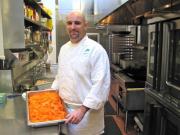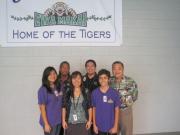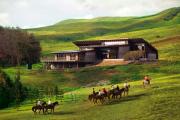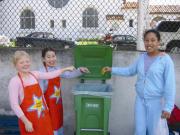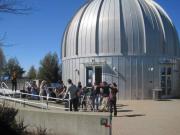Chicago's Green Schools
During a beautiful, early fall week in September, I had an opportunity to visit some of the Chicago's greenest public schools: Peterson Elementary School, Vaughn Occupational High School, Waters Arts Magnet School, and Curie Metropolitan High School. This was also an occasion for me to return to my alma mater, Hinsdale Central High School. And I also had a chance to visit with three independent schools that are going green: The Latin School, The University of Chicago Lab Schools, and Morgan Park Academy. I was proud of the collective sustainability initiatives underway in my native land.
1. Chicago Public Schools: Green Schools for a Green City
In September I traveled to my hometown of Chicago to study how the city has gone green and the role that schools have played in that process. In the late 1980s, then Mayor Richard Daley declared his “commitment to enhance our environment and make Chicago the most environmentally friendly city in the nation” at a time when climate change “wasn’t on the radar” for most people, let alone most cities and nations. Beginning with an initiative to plant 500,000 trees in the City, Chicago systematically embraced a series of environmentally sustainable initiatives from “green roofs to green buildings and policies.” In 2008, Chicago announced its visionary Climate Action Plan that declared climate change is a “worldwide threat to our planet…that demands an encompassing plan from every city, state and nation and action from every resident and business….” The City embraced the Kyoto Protocol, declaring Chicago’s commitment to reducing greenhouse gas emissions 80% by 2050, with the steepest reductions coming by 2020. The plan outlined five areas for action: energy efficient buildings, clean and renewable energy solutions, improved transportation options, reduced waste and industrial pollution, and adaptation.
With the City’s political leadership showing the way, the Chicago Public Schools set out achieve ambitious goals for environmental sustainability. In 2008 the district created its own Environmental Action Plan, with a mission that includes “minimizing our impact on the environment and teaching students to be environmental stewards” (Environmental Action Plan). The plan focuses on six areas--transportation and air quality, energy, waste, land, water, and engagement--with 26 specific strategies to transform the schools. In 2010 Suzanne Carlson, who was then Director of Environmental Affairs, commissioned an Environmental Programming Assessment to establish a rubric for monitoring progress and to direct future actions. The analysis showed positive results in the tangible areas of air quality, transportation, waste, water management, and the expansion of school gardens. It also pointed to the need for enhanced focus on integrated curriculum and student engagement.
Chicago’s new Sustainability Manager, Meredith McDermott, has taken on her challenging responsibilities with gusto. She was raised in Southern California, where as an avid swimmer and scuba diver, she developed a “love of nature and diverse habitats that stems from my connection to the ocean. Passion for the environment usually comes from a personal place!” When her family moved to the Chicago area, she attended Fenwick High School in Oak Park and then received her B.S. from the University of Illinois at Champaign-Urbana in environmental biology and natural resources. Love of travel and academic curiosity led her to add M.S. degrees from the University of Queensland in Australia in environmental management and marine science.
In the remarkable day we spent together, we saw that the environmental sustainability imperative in action at four very different Chicago public schools: Peterson Elementary School, Vaughn Occupational High School, Waters Arts Magnet School, and Curie Metropolitan High School.
Peterson Elementary School
Peterson Elementary School’s motto, “where the world comes to learn,” speaks volume about the rich diversity of this growing school with some 950 students. About a third each are Hispanic and Asian, and the student body includes 30 languages, 65 nationalities, and over seventy percent are low income. The school was founded in 1926 on land donated by a woman named Mary Peterson, an avid conservationist who wrote Nature Lover's Creed. Peterson’s effort to become a model, green elementary school has been led by an energetic and youthful team of administrators, teachers, and parents. Principal Adam Parrott-Sheffer was raised in the golden hills of California’s Bay Area, where he developed his love of nature. He moved quickly to support the work of the passionate Green Team at Peterson. Parent Lloy Johnson grew up in rural Connecticut, married a Colorado environmentalist who works for the Chicago Conservation Corps, and together they raise their children and chickens at their home in the neighborhood. Her partner on the Green Team, Susan Casey, grew up a “free range kid” in South Chicago, developed a love of science, and has helped the school embrace low-tech, high impact environmental strategies, especially the recycling program. Faculty member Zach Korth, who grew up on a farm in Iowa, leads the Green Team and teaches middle school math and science with a green theme.
The school’s environmental sustainability accomplishments are evident everywhere. The campus was recently renovated with the installation of efficient lighting and includes a newly constructed wing that will be LEED-Silver certified, the standard adopted by the Chicago Public Schools. The campus includes a geothermal system that utilizes the constant subsurface ground temperature to reduce expenses for heating and cooling the facility. A fully developed recycling program and newly added green waste removal and composting helps reduce waste. A section of green roof provides a window for students to view the original native plants of the Illinois prairie. In middle school science, students are designing and constructing a “living wall” that will be installed in the school’s foyer. With strong parent leadership and neighborhood partnerships, the school installed its own garden and is beginning to incorporate fresh, local, and seasonal food into the kitchen for the students. In 2004, Peterson received a grant from the Illinois Conservation Foundation to fund the school's "Classroom in a Garden" project in order to develop an outdoor garden curriculum for the 300 first through third-grades students. Looking to the future, the school is raising the $400,000 that will be needed to install a “sustainable schoolyard,” complete with native plants and a rainwater bioswale.
Vaughn Occupational High School
Led by Principal Rusty Burnette, Vaughn Occupational High School and his team provide a remarkable, educationally sustainable program for 215 students with cognitive, developmental, and multiple disabilities. Vaughn's mission is to “teach its students individualized, functional academics, emphasizing occupational development and independence.” Rusty Burnette himself was raised on a Virginia farm, and after years teaching special education (in which he holds a Ph.D.) in schools and college, he trained to become a principal through the New Leaders for New School program. Arriving at Vaughn six years ago, he brought a progressive, student-centered outlook and a firm belief in John Dewey’s “learn by doing philosophy.” Principal Burnette’s passion and knowledge is evident everywhere.
The principles of environmental sustainability are especially well suited for the Vaughn mission. The school itself is located in a former phone company building that was repurposed and renovated to serve the students. The school’s building engineer has helped the effort to make it green and achieve environmentally sustainable standards for existing buildings. Students play a central role in the school’s operation as they are trained and responsible for cleaning the entire building using eco-friendly products. With a goal of zero waste, the school proudly declares that everything is recycled or reused. The school also recycles for the neighborhood community and creates paper to print postcards, greeting cards, and envelopes that are sold to fund student stipends. A well-developed vermicomposting system enables the students to bag organic compost and sell it for profit at the local farmers market, learning math and business skills along the way. With approximately $150,000 in grant money, Rusty Burnette and his team were able to transform a parking lot into a green, artificial turf field used in physical education. He also implemented a plan enabling 60% of the students to get to school independently, reducing the number of bus runs from 26 to 16 to save emissions. The curriculum builds partnerships in the community where, for example, students conduct trail maintenance and run science experiments in the local forest preserve and run a landscaping service for local residents. Perhaps most impressively, the school’s Culinary Arts Department trains students to run the school’s café and restaurant, which now uses the vegetables and herbs grown in the science department green house.
Thomas J. Waters Elementary School
The Thomas J. Waters Elementary School, an arts magnet school, has made such significant strides in becoming sustainable that it was recognized this year as a Green Ribbon School by the U.S. Department of Education. Principal Titia Crespo, who was raised on a dairy farm in Vermont, came to Waters 18 years ago as an art teacher with a philosophy that every day should focus on “kids first.” Over the years she became the Arts Director and eventually the Principal, gradually nurturing the development of environmental sustainability. About Water’s recognition as a Green Ribbon School, she observed, “we did not set out to do this;” it developed naturally, guided by the school’s mission “to provide hands- on authentic learning in all content areas for all students.” She proudly notes that the Green Ribbon application itself was prepared by a parent volunteer. Visiting this K-8 school of 617 students in Chicago’s Northwest side, it is clear why they have been recognized for the high quality of their environmental accomplishments in their facilities, operations, and curriculum.
The school’s environmental educational program is guided by Peter Leki, who has developed a widely-recognized and unique field-based program for all Pre-K through 8 students that is integrated across multiple subjects within Waters’ program. He began his work as a volunteer in 1991, and the school subsequently raised extra funds to create his special faculty position. The day I visited, students were eagerly preparing for a field trip to the nearby Chicago River, where students run field experiments and have restored a four block section of the watershed. The river originally ran through the site of the present campus before it was re-routed, and Waters has created a bioswale atop the former location. The campus itself is an oasis in the surrounding residential community, filled with extensive gardens with vegetables, herbs, and flowers that the neighbors help to maintain. Years ago, the Waters playground was a traditional 1.2 acre patch of worn asphalt. Through the dedication and hard work of parents, students, and neighborhood volunteers, most of the asphalt was removed over a 15 year period. However, it was a creative and successful campaign led by the 2002 8th grade class that prompted the Board of Education to remove the final asphalt. The beautiful area has been restored with native plants and a large artificial turf lawn for recreation. With its integrated focus on all elements of a green school—efficient facilities, healthy operations, and an immersive ecology curriculum—it is easy to see why the U.S. Department of Education honored Waters Elementary as one of the nation’s first Green Ribbon Schools.
Curie Metropolitan High School
Named for the famous Polish-American who won a Nobel prize for her discovery of radioactivity, Curie Metropolitan High School is a public magnet school located on Chicago’s southwest side that serves 3600 students, 88% of whom are Hispanic and African American; over 90% are low income. With technical, performing arts, and International Baccalaureate programs, as well as offerings in communications and media studies, the school strives to prepare its students for college and to “become leaders and engaged citizens in a global society.” Built 40 years ago in a classic brick box style, the school is typical of large, comprehensive high schools from that era. As might be expected, greening a school of this size and complexity is not a simple task. Fortunately for Curie, they have dedicated champions leading the way.
Shane Crone is a physics teacher who heads the Curie Green Team and has brought a dedicated, innovative approach to helping the school become more environmentally sustainable. A graduate of the University of Illinois at Chicago with a B.S. in physics, his five-class, 125-student load keeps him very busy but still he finds time to support students and faculty eager to make change. Shane is especially proud of Curie’s involvement in the Climate Cycle Ride, a fundraising initiative created by a nonprofit partner organization. The annual event involves 100 area schools and Curie has won four years consecutively. Jasmine Vasquez, also a Curie teacher, has been instrumental to the school’s success with Climate Cycle through her dedication to and leadership of the Bike Club. These combined efforts helped to raise $35,000 for Climate Cycle and netted the school $14,000 to support sustainability projects. Shane Crone has systematically obtained additional grant funding to acquire solar panels that provide 6 kW of electric power to the school that could soon increase to 12kW with new grant money; he estimates that there is potential for a large 100 kW system. He uses the school’s renewable energy system, as well as its on-campus weather station, for data analysis in his science classes. The Curie Conservation Corps, for which he serves as advisor, seeks to “reduce our school’s carbon footprint and educate our school and surrounding community about the climate, health, and sustainability issues that we face from our energy dependence.” With an objective of getting 75% of the faculty to turn off the lights on sunny days, he calculated the $134.03 saved in the 2010-11 school year just from his own Room 346, where he has also installed three bike-desks that enable students to generate electricity while learning science.
Elsewhere at Curie, students are involved in other sustainability activities. The Ecology Club leads recycling efforts for the vast student population. Erin Faulkner, another school champion, leads the Green Action Nature Club that leads such activities as invasive plant removal from the surrounding neighborhood. Ms. Faulkner also leads the Compost Club, measuring annual progress in waste diversion. Curie’s Garden Club maintains four raised-bed gardens that produce edibles and enhance green space.
Chicago Public Schools are clearly deeply engaged in the effort to fulfill the city’s ambitious Climate Action Plan goals. The schools also face significant challenges, as was clear in the teachers’ strike that made national headlines and closed the schools for two weeks before my visit. With issues ranging from teacher evaluation and compensation to student test score performance and the length of the school year, it is surely difficulty to focus on the longer-term matters of the environment and sustainability. Yet Sustainability Manager Meredith McDermott brings experience, enthusiasm, and commitment to this vital task. As she observes, “Education is the foundation of conservation.”
2. Hinsdale Central High School: Alma Mater Going Green
This fall I returned to my alma mater during homecoming weekend for a reunion with classmates and to join the Hinsdale Hall of Fame. Annually, the Hall of Fame Foundation identifies several graduates, and raises money to support professional development for teachers and leadership development for students. It was an honor to be welcomed back with a great group of alumni, including the woman who swam on the boys’ team in 1971 and helped open up Title IX equity for girls in education, a parent leader who exemplifies the volunteer spirit in the community, the CEO of BP appointed to steer the company after the Gulf Oil spill, and one of the nation’s foremost prostate cancer specialists.
Being back in my hometown, a small village of 7000 when I was a kid, and back at my school, one of the country’s top public high schools, reminded me how fortunate I was to receive first-rate education from my teachers, and from my friends. Hinsdale continues its focus on academic excellence through an Advanced Placement program in which students sit annually for nearly 1000 exams in 26 subjects. The school believes in the ideal of the scholar-athlete, and Hinsdale students have won many state championships and set international and Olympic records. Importantly, the reunion also gave me the chance, amidst all these memories, to discover that my alma mater is beginning to focus on becoming more environmentally sustainable. While in town, I remembered some of the formative experiences that helped me become attuned to nature. We were “free-range kids” in the fifties and sixties, and I spent a great deal of time outdoors, riding bikes, playing sports, skating and sledding in the winter, tending our backyard garden, camping with the Scouts, building tree forts, swimming and sailing in Lake Michigan, and marveling at the beauty of seasonal changes. My Midwestern childhood surely played a large role in the life I have been able to lead, as a father, educator, and citizen.
Walking up to the entrance of the red brick, two story high school built just after the Second World War, I was greeted by a sign that proclaimed “Red Goes Green” announcing the well-developed recycling campaign. The school frontage was being prepared by landscape architects who were installing a bioswale the length of the building that will capture rainwater and reduce run off. The athletic staff proudly showed us the new artificially turfed fields that conserve water and reduce the use of harmful chemicals. Our luncheon was prepared and served by students enrolled in the school’s new Chef and Restaurant class, with food sourced through Peapod.com, a locally-based, nationally positioned on-line grocery service that offers local, organic and seasonal fare to the students. From my tour of the newly renovated facilities and science wing, filled with the natural light I remember from my schooling, it was clear that the school has continued its excellence in science education. Students were engaged in a wide range of advanced classes, AP Chemistry and AP Physics (which I took as prototypes in the early 1960s when the Cold War stimulated a desire to make American high students more competitive internationally) and the new AP Environmental Science.
Two pioneers are working to make Hinsdale’s commitment to becoming a green school more intentional: Science Department chair Lisa Fernandez and English Department teacher and Ecology Club advisor Cherise Lopez. Raised in a rural part of Lake Forest to the north of Chicago, Lisa Fernandez remembers growing up close to nature in a home with dogs, cats, horses, goats, rabbits, chickens, and turkeys, and their ample garden and orchard produced tomatoes, grapes and apples for their table. “I spent a lot of time outdoors and have always appreciated nature thanks to my parents,” she recalls, and she was inspired to become a chemistry teacher, which she has taught at Hinsdale for twenty years. For Lisa, environmental sustainability is important in education because “it is our responsibility as citizens to care for the earth.” Cherise Lopez advises the Ecology Club and has made a recent study of Chicago’s Academy for Global Citizenship, which was awarded a Green Ribbon Schools award this year for its achievement in environmental sustainability. She was raised to the west of the city in Cicero and “developed a love for nature because I constantly played outside and spent many days at Lake Michigan with my family.” “From a young age,” she recalls, “I absolutely adored animals and realized that they relied on the environment for survival, as do humans. This realization prompted me to understand human impact on nature, and then ways to minimize harm.” “Environmental sustainability in education is important,” she says, because “more so than ever humans are still using resources that have not been replenished….Showing students from all ages that they can actually modify behavior to create positive change may actually empower them to become sustainability leaders.”
With leaders like Lisa Fernandez and Cherise Lopez, and the commitment to excellence that characterizes the community to this day, Hinsdale Central High School appears well positioned to make a major effort to become more environmentally sustainable.
3. Latin School: Classically Green
True to its mission of academic excellence when founded in 1888, Latin School of Chicago has embraced a classical vision of environmental sustainability, one that carefully and thoughtfully incorporates a great number of best practices in the design and operation of this K-12 school for 1100 students on the city’s north side. I first learned about Latin when my sister-in-law taught art there in the early seventies. Over the years, I have made regular visits to Latin to learn about and adopt many innovative ideas, and on this latest stop I was delighted to discover their leadership in creating a green school.
Latin School has made efforts to conserve for many years, but the modern, systemic sustainability program took off in the 2007-08 year. Then Head of School Don Firke asked that the new strategic plan contain a “commitment to environmental sustainability,” and soon thereafter Latin established the Environmental Stewards Committee to guide the emerging initiative. As a first step, the school joined the Green Schools Alliance and committed to steep reductions in its carbon footprint. When current Head of School Randall Dunn arrived in 2011, he decided to build on the school’s momentum and in a recent conversation credited the leadership of two key administrators, Director of Facilities and Operations Peter Brown and Director of Student Life Tim Cronister, for the school’s success.
In 2009 Latin’s Board of Trustees adopted an Environmental Sustainability Statement that declared the school’s commitment to “educating its students, through both program and practice, on the issues and public policies concerning environmental sustainability” so that the “graduates will lead lives of purpose and excellence; they will desire to make a difference in the world; and they will recognize the fundamental importance of public service and respect for others and the environment.” The policy further described Latin’s intention to reduce its carbon footprint “by paying careful attention to the construction and renovation of our facilities, by educating our students and school community in innovative ways about the environmental impact of various policies and decisions, and incorporating environmental education into our curriculum.”
This environmental charter has inspired remarkable, systemic change, led in part by Peter Brown and Tim Cronister. As Peter Brown explained, he grew up in the Chicago area spending a great deal of time outdoors, discovering nature in the surrounding wetlands, and eventually becoming an Eagle Scout. For him, as the Manager of Auxiliary Services with the University of Chicago Lab Schools and now as the Director of Facilities and Operations with Latin, a belief in the “triple bottom line” moved him to seek significant operational savings that he was convinced would promote a healthy community and boost student achievement. His colleague Tim Cronister attended the Westtown School where his parents were teachers, and he loved roaming the 600 acre campus and spending time at a camp in Vermont. His position as Director of Student Life enables him to integrate many student leadership, experiential and outdoor education programs with sustainability initiatives.
As a result of its mission and careful attention to systems change, Latin School has incorporated an impressive array of environmentally sustainable actions in its facilities and operations. This past year, the new Middle School Building achieved LEED Gold certification from the US Green Building Council, where Peter Brown sits on the Green School Advocacy Committee. During its construction, the school diverted 85% of the waste from landfills. The school facility highlights many innovative features, including the school’s third green roof, a second set of PV solar panels and a “bird friendly” wind turbine, and a solar hot water heater. The school now generates over 18 kW of renewable power. After completing a Sustainable Building Assessment several years ago with EcoHill, school-wide renovations have brought energy efficiency through a multi-year HVAC upgrade, installation of hallway and classroom light sensors, daylight harvesting and dimmable ballasts. An Environmental Monitoring System by Automated Logic tracks and promotes awareness about sustainability.
Latin has taken meticulous care to follow the "reduce, reuse, recycle and rot" mantra. Some of the highlights include: 100% recycled paper, all copier and printer toner cartridges recycled, reuse of all packing and shipping materials, battery recycling stations around the school, reusable water bottles provided to all students, an ambassador program to turn off printers at night, and Spirit shop items featuring 100% organic cotton printed with soy-based ink and clothing made in the USA. And this list only scratches the surface!
The school has rethought its lunch program to incorporate seasonal, organic and locally produced food, leading to Latin winning the Golden Beet Award from the Illinois Stewardship Alliance in 2011. The cafeterias have eliminated styrofoam cups, soup bowls and to-go containers in all three locations and increased availability of melamine dishware to reduce disposables. Food service scraps are now used for worm farms in science classrooms, and organic waste is composted off site by the school’s waste management company.
With a highly efficient facility and healthy operations, Latin is now turning its attention to the part of the 2009 Environmental Statement that focuses on “incorporating environmental education into our curriculum.” The progress was evident in my quick tour, in an amazing, interactive globe that illustrates everything from the planet’s geological to climate change. In 2011 the student body entered the Green Cup Challenge and came in first place regionally by reducing energy usage by 7.4%. And a number of student clubs provide a forum for students to learn about environmental issues. This year the school has decided to focus its service program on building a partnership with the nearby Uptown Neighborhood to create opportunities for students to learn about the local community and environment.
The Latin School is clearly well engaged in transforming its culture to become more environmentally sustainable. Having noticed that the Latin web site does not fully tell the school’s remarkable story, I have urged the leaders to share their amazing accomplishments. We all will benefit from learning how a classically-founded school has become progressively green.
4. The University of Chicago Lab Schools: Green By Doing
John Dewey would be proud of the Greening Lab Initiative underway at the University of Chicago Lab Schools that he founded more than a century ago in 1896. His progressive philosophy of education emphasized that children learn best by doing, through hands-on experimentation and exploration. He also urged a child-centered approach in which teachers help students discover and develop their many talents. Dewey saw the school as a community unto itself, but also connected into the local neighborhood, and he believed the school was the engine of democracy where young citizens could be nurtured. Today his innovative school has grown to nearly 1800 students in four divisions from pre-school to twelfth grade and is making strong progress in discovering its own green, environmentally sustainable identity in the 21st century.
The school’s director, David Magill, came to the Lab Schools in 2003, and he found there was a large agenda--renovating an aging physical plant and expanding enrollment--that was only partially connected to sustainability. He credits marrying his Ohio State classmate, who grew up on a farm, with his first connection to nature, and in his years working as superintendent of the Lower Merion Public Schools outside Philadelphia, he was pleased with early initiatives like the conversion of all school buses to compressed natural gas. Al Gore’s film Inconvenient Truth inspired him to establish a Green Team early in his time in Chicago, and he appointed the Manager of Facilities, Scott Griffin to coordinate the school’s efforts. A Green Team was established and adopted a mission statement in which the students declare that they aim to “raise awareness of the deteriorating condition of the environment,” “engage the school and community into being more environmentally sustainable,” and “instill an environmental consciousness that will become innate and remain with us wherever we go.” John Dewey would give them high marks for their democratic ideals!
Every school striving to become green needs a champion, and the Lab Schools have that person in Gail Poole, who serves as the Physical Education and Athletics Coordinator. For her, environmental sustainability is a family commitment; her father worked for the Environmental Protection Agency and her daughter is an environmental engineer specializing in wastewater management who just received a Young Professionals Award in recognition of her efforts. Gail Poole herself has pursued training at the University of Chicago’s Graham School, where she took courses on Eco-Design with the University’s former sustainability project manager and where she recently completed a full-year certificate program on Leadership in Sustainability Management. While her responsibilities have not yet been fully formalized, she is clearly playing a vital role in the Lab Schools’ green efforts, advising the Upper School Environmental Club, coordinating with the University’s Sustainability Director, attending the regular meetings of the University’s Sustainability Council as a council member, connecting with the Illinois Green Governments Coordinating Council, and spearheading the Greening Lab Initiative.
Greening Lab has accomplished a great deal since it was initiated in 2008, when the Green Team developed an action plan to launch “major initiatives for improving education and sustainability-related programs on the Lab campus.” When the school joined the Green Schools Alliance, the students quickly embraced the Green Cup Challenge to reduce energy consumption, won a grant from the Alliance for Climate Education, attended the SC3 (Student Climate and Conservation Congress) leadership development conference, and launched various initiatives including an annual eWaste drive. Parents created an Environmental Sustainability Committee to “advocate for positive change within the Schools.” The Greening Lab Initiative also offers community service opportunities to students, one successful project accomplished reducing junk mail sent to the school by 500 pounds. A Peer Leadership Program has “taken on an emphasis on sustainability and environmentalism.” Host to Chicago’s 350.org event in 2010 to dramatize the impact of climate change, the school is connecting to green organizations in the wider world, as a member of the Illinois Sustainable Schools Compact and the Chicago Conservation Corps.
The emerging environmental sustainability initiative has other important allies in the Middle, Lower, and Early Childhood Schools at the Lab Schools. It was great to reconnect with Carol Swainson, who has started her new work as Middle School Head, and was my colleague at Head-Royce School where she was a key leader in our efforts to become a model green school; while she has just come on board already she is working to create a new Sustainability Innovation classroom, envisions refocusing the Home Economics class on a healthy food program, and is working with the Parents Association to introduce an aquaponics program. As a kid growing up in Mississippi, Lower School Head Sylvie Anglin remembers “spending her entire life outdoors,” and the love of nature she developed has motivated her to develop the environmental education in her division. She is pleased to be using the resources of nearby Jackson Park, which was created in 1893 when Chicago hosted the World Fair, and features a variety of lakes and wooded areas that are a perfect setting for getting students outside in nature.
Environmental sustainability is a growing priority for the Lab Schools. The new, LEED certified Early Childhood Center will open as a second campus in the fall of 2013 and signals a new emphasis on sustainable building at the University of Chicago, which oversees the operations of the Lab Schools, which constitute a department within the university. It is clear that Lab is doing important work in all five key areas essential to greening the school--facilities, operations, curriculum, food, and students engagement. With additional time, focus and resources, it is also clear that the University of Chicago Lab Schools will be able to incorporate sustainability into all aspects of their culture.
5. Morgan Park Academy: Toward a Sustainable Future
Growing up in the Chicago suburbs, I have for a long time known about Morgan Park Academy, so it was wonderful to visit and discover this historic school that is in the midst of developing its vision of environmental sustainability. Founded in 1873 on 22 acres in the southwestern section of the city, Morgan Park Academy originally was a feeder to the University of Chicago that was then located nearby. Today the PK-12 school serves a diverse student body of 450 from the city and the surrounding southwestern suburbs as far away as Northwest Indiana; nearly two-thirds are students of color, forty[C1] percent are African American, and there are a dozen international students. With a mission to prepare “the global leaders of tomorrow to make a positive difference in the world,” MPA is actively working to become a green school.
In 2008 Catherine Raaflaub arrived as the new Head of Morgan Park Academy, and in “the aftermath of the economic downturn,” helped the school craft a new Strategic Plan, “Toward a Sustainable Future.” A key part of the plan called for “a sustainable campus environment.” They identified a number of key action steps, including an energy audit, commitment to using energy-efficient products, a plan to reduce the ecological footprint, a “rethink” of how to restore the campus in a sustainable way, and a desire to incorporate environmental sustainability into all aspects of the curriculum. From my visit to Morgan Park Academy, it is clear that the school is moving vigorously to become greener.
It is exciting to see the school’s strong administrative team coming together to the implement the brand new Morgan Park Academy Sustainability Plan that outlines the vision and the process to reduce the school’s carbon footprint. Catherine Raaflaub[C2] brought to the school her belief that “sustainability is a global problem that begins at home.” With a Ph.D. in education, she has organized her team for leadership. The new Director of Sustainability, Sarah Haskins, teaches French in all divisions, lives on campus, and is responsible for the school’s garden. She works closely with CFO Mercedes Sheppard, and together they are implementing the energy audit and focusing on how to change adult behavior by creating feedback loops. They are joined by Lower and Upper School Deans Annie Melville and Tom Drahozal, both veteran educators with a strong commitment to sustainability. Annie Melville, with memories of her family’s rooftop garden in Brooklyn, is developing the K-4th grade garden curriculum so that students know where food comes from. Tom Drahozal is proud of the 100% on-campus composting program and the curricular projects that are focused in the local area, like River Watch that studies water quality on the nearby Calumet Sag Channel and the Indiana Sand Dunes restoration project. Dean of Student Life Tom Malcolm, a Middle School science teacher who has been with MPA for 37 years and was raised on a farm in Indiana[C3] , is spearheading the school’s efforts to seek LEED certification for any new construction and building renovations.
It was a special pleasure to meet with Paul Boundas, the chef-owner of The Country House Restaurant in suburban Chicago, who has led the effort to green the MPA lunch program[C4] . Responding to a request from parents in 2002, he secured a contract to run Morgan Park Academy’s food service. Over the last decade he has built his business to run five scratch cooking kitchens that now serve 4,500 students in seven private schools. At MPA, he says that the kitchen makes food from scratch with mostly fresh and unprocessed foods that are purchased from local farmers less than 10 miles away. The kitchen is green for a number of reasons: transportation costs are reduced, the food is often organic and grown with fewer chemicals, packaging is greatly reduced, and the cafeteria operates with real dishes and utensils. With a masters degree in psychology, Paul Boundas is keenly aware of the importance his program has for student health, and in 2011 Harvard University and the Culinary Institute of America invited him to present his program at the Healthy Flavors, Healthy Kids national conference. Morgan Park Academy is rightfully proud of its nationally recognized food program.
The effort to green the food service has been complemented by the large campus garden. Students play a key role in preparing the garden beds, planting seeds, and[C5] relocating young plants, as do students in the After School Sustainability Club. On our mid-September tour, the garden’s bounty was evident; there were corn stalks and sunflower plants, cantaloupes, watermelons, cucumbers, gourds, and green beans. Basil, oregano, and other herbs are used in the cafeteria lunch program[C6] .
The campus facilities include a number of handsome, early twentieth century buildings that will need to be retrofit to improve their energy efficiency. With its new Sustainability Plan, clear vision, and committed leadership team, however, Morgan Park Academy is surely poised to make significant progress in the years to come. It is clear that MPA has in place all the elements that will help the school achieve its vision of a sustainable future.

